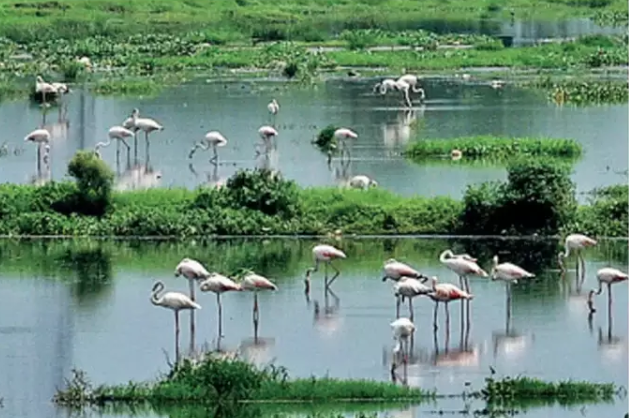Context:
Two Bird Sanctuaries in Bihar added to the Ramsar List.
Key Highlights
- Two wetlands in Bihar, namely Nagi and Nakti bird sanctuaries, have been included in the global list of wetlands recognized as internationally important under the Ramsar Convention.
- This brings the total number of Ramsar sites in India to 82.
- Both sites were declared as Wetlands of International importance on the occasion of World Environment Day on June 5.
Location: Both Nagi and Nakti bird sanctuaries are situated in Bihar’s Jamui district.
- These are man-made reservoirs located in the Jhajha forest range of Jamui, characterized by their catchments featuring dry deciduous forests surrounded by hills.
- This recognition is expected to bolster bird conservation efforts in the region.
About Nakti Bird Sanctuary
Development and Habitat: The Nakti Bird Sanctuary was primarily developed for irrigation through the construction of the Nakti Dam.
- Since its construction, the wetland and surrounding areas have become a habitat for over 150 species of birds, mammals, fish etc.
- Notably, it includes globally threatened species such as the endangered Indian elephant and a vulnerable native catfish (Wallago attu).
Designation and Importance: Designated as a Bird Sanctuary in 1984, Nakti is a crucial wintering habitat for migratory species, attracting over 20,000 birds, including one of the largest gatherings of red-crested pochards on the Indo-Gangetic plain.
- A bird sanctuary is a protected area of habitat that is specifically designed to protect birds.
About Nagi Bird Sanctuary
Formation and Biodiversity: The Nagi Bird Sanctuary was formed following the damming of the Nagi River, leading to the creation of water bodies with clear water and aquatic vegetation.
- Its significance for migratory bird species led to its local recognition as a Bird Sanctuary in 1984, and later, its international recognition as an Important Bird and Biodiversity Area (IBA) by BirdLife International.
- BirdLife International is a global partnership of non-governmental organizations (NGOs) that works to conserve birds and their habitat.
Habitat and Species: The Nagi wetland and its fringes provide habitat for over 75 bird species, 33 fish species, and 12 types of aquatic plants.
- It is particularly notable for hosting one of the largest congregations of bar-headed geese on the Indo-Gangetic plain.
Ramsar Convention
The Ramsar Convention, also known as the Convention on Wetlands of International Importance, is an intergovernmental treaty signed on 2nd February, 1971, in Ramsar, Iran.
- 2nd February every year is celebrated as World Wetlands Day.
It aims to recognize and conserve wetland sites of international importance and promote its wise use. It is the only global treaty to focus on a single ecosystem.
- wetland is an area of land that is saturated with water, either permanently or seasonally.
- Its Secretariat is located in Gland, Switzerland.
The countries with the most Sites are the United Kingdom with 175 and Mexico with 142.
- Bolivia has the largest area with 148,000 square km under the Convention protection.
- The Convention came into force in India in 1982.
- The first Ramsar Site designated in India was Chilika Lake (Odisha) in 1981.
Process for Declaring a Wetland as a Ramsar Site in India
- The Ministry of Environment, Forest, and Climate Change (MoEFCC) serves as the nodal ministry for wetland conservation.
- The concerned state government submits a proposal to the MoEFCC, recommending the wetland for Ramsar designation.
- Upon approval by the MoEFCC, the proposal is submitted to the Ramsar Secretariat.

